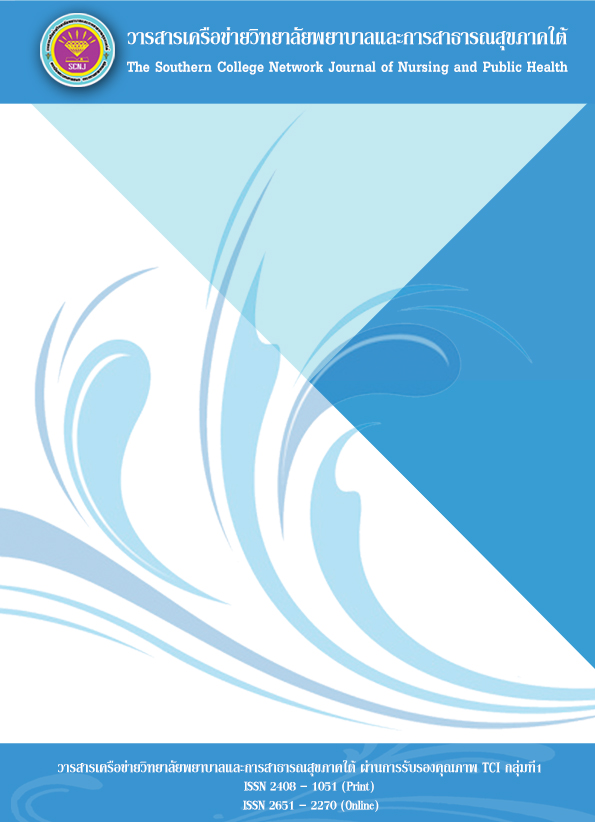ความปลอดภัยของผู้ป่วย: แนวทางจัดการเรียนรู้ภาคปฏิบัติทางการพยาบาล
คำสำคัญ:
ความปลอดภัยของผู้ป่วย, การจัดการเรียนรู้ทางการพยาบาล, การจัดการเรียนรู้ภาคปฏิบัติบทคัดย่อ
สถานบริการสุขภาพทุกระดับ และผู้ประกอบวิชาชีพด้านสุขภาพ ให้ความสำคัญเรื่องความปลอดภัยของผู้ป่วย และมีความพยายามในการพัฒนาระบบบริการให้มีคุณภาพ เป็นที่ไว้วางใจ สามารถตอบสนองความต้องการและความคาดหวังของผู้รับบริการ ดังนั้น การจัดการศึกษาวิชาชีพการพยาบาล ซึ่งนักศึกษาต้องฝึกปฏิบัติการพยาบาลในสถานการณ์จริง จึงควรบูรณาการการจัดการเรียนรู้เรื่องความปลอดภัยของผู้ป่วยเพื่อบ่มเพาะ และสร้างรากฐานการเรียนรู้เรื่องความปลอดภัย ปลูกฝังทัศนคติและเสริมสร้างการปฏิบัติอย่างปลอดภัยจนเกิดความตระหนักถึงความปลอดภัยของผู้ป่วยเป็นลำดับแรกในทุกกระบวนการของการฝึกปฏิบัติ ดังนี้ 1) บูรณาการความปลอดภัยของผู้ป่วยในหลักสูตร 2) เตรียมความพร้อมของนักศึกษาอย่างมีประสิทธิภาพ ได้แก่ พัฒนาสมรรถนะทางวิชาชีพ และปฐมนิเทศการฝึกปฏิบัติ 3) จัดการเรียนรู้สู่การปฏิบัติอย่างปลอดภัย ได้แก่ สร้างบรรยากาศการเรียนรู้ที่เกื้อหนุน แก้ไขปัจจัยปัจเจกชนที่โน้มนำให้เกิดความผิดพลาด กระตุ้นนักศึกษาให้มีความพร้อม มีสติ และคิดถึงความปลอดภัยของผู้ป่วยทุกลมหายใจ ดักจับและปรับลดโอกาสเกิดความผิดพลาด ส่งเสริมสนับสนุนการใช้หลักฐานเชิงประจักษ์ในการปฏิบัติงาน สอดแทรกแนวคิดความปลอดภัยในทุกกิจกรรม ใช้แนวคิดการมีส่วนร่วมของผู้ป่วยในกระบวนการดูแลรักษา ใช้แนวคิดห่วงโซ่การป้องกันแก้ไขก่อนเกิดภาวะวิกฤต และเรียนรู้ระบบบริหารความเสี่ยงและความปลอดภัย 4) จัดช่วงเวลาแลกเปลี่ยนเรียนรู้เรื่องความปลอดภัยของผู้ป่วย 5) ทำให้นักศึกษากล้าเปิดเผยความผิดพลาด และ 6) ผู้สอนเป็นต้นแบบการปฏิบัติอย่างปลอดภัยและมีจริยธรรม
เอกสารอ้างอิง
Bureau of information. Office of The Permanent Secretary, MOPH. (1017). Safety Patient and Health Personnel Safety Strategy of Thailand. Retrieved from https://pr.moph.go.th/iprg/include/admin_hotnew/show_hotnew.php?idHot_new=100626 (in Thai).
Cant, R. P., & Cooper, S. J. (2010). Simulation-Based Learning in Nurse Education: Systematic Review. Journal of Advanced Nursing, 66(1), 3-15.
DeMaria, J. (2017). Organizzational Safety Culture. Retrieved from https://ishm.org/organizational-Safety-Culture.
Dzau, V. J. (2017). Global Patient Safety 2017: A Call to Action. National Academy of Medicine Second Global Ministerial Summit on Patient Safety.Retrieved from https://www.bundesgesundheitsministerium.de/.../Patientensicherheit/Key.
Jormsri, P., Klunklin, A., Tunmukayakul, O., & Srisuphan, W. (2010). Perception of Nursing Principles among Nurses in Thailand. Thai Journal of Nursing Council, 25(1), 27-37. (in Thai).
Khalaila, R. (2014). Simulation in Nursing Education: an Evaluation of Students' Outcomes at Their First Clinical Practice Combined with Simulations.Nurse Education Today, 34(2), 252-258.
Khemmani, T. (2011). Analysis, Synthesis, Creative and Critical Thinking Skills: Integration in Teaching-Learning Plan. The Journal of the Royal lnstitute of Thailand, 36(2), 188-204. (in Thai).
Kumkong, M., Leejareon, P., Aramrom, Y., & Jittiboon, A. (2016). The Effect of Simulation Based Learning on Self-Efficacy in Providing Nursing Care and Advance Life Support for Patients with Critical Illness or Emergency among Nursing Students. The Southern College Network Journal of Nursing and Public Health, 3(3), 52-64. (in Thai).
Labson, M. (2013). SBAR-a Powerful Tool to Help Improve Communication. Retrieved from https://www.jointcommission.org/blogs/blogger.aspx?BloggerId=385
Lerdbunapong, T. (2015). Simulation Based Medical Education. Siriraj Med Bull, 8(1), 39-46. (in Thai).
Limpanyalert, P. (2016). 2P Safety Patient and Personnel Safety. Retrieved from https://hacc.kku.ac.th/haccupload_news/pdftitle/Tue24545uFpjMOP.pdf (in Thai).
Lohapaiboonkul, N., & Palakarn, B. (2013). The Effects of an Objective Structured Clinical Examinations (OSCEs) Test to Evaluate The Knowledge and Clinical Skills in Basic Medical Treatment and Perceive of Preceptors from Community of The Clinical Skills of Nursing Students. Nursing Journal of The Ministry of Public Health, 23(3): 24-34. (in Thai).
Mathapun, K. (2013). Factor Associated with Perceived Safety Culture in Personel: A Case Study of a Private Hospital Group in Thailand (Public Health). Major in Health Admistration. Graduate School of Mahidol University. (in Thai).
Panich, V. (2011). Education and Research of Patient Safety: Tool for Educational Reformon Health Professional Education. Retrieved from https://www.gotoknow.org/posts/468432. (in Thai).
Sirinakorn, R. (2014). Risk Management. Handout for Short Course Training Hospital Infection Control and Prevention. Retrieved from file:///C:/Users/malee/Downloads/Risk%20%20management(1).pdf (in Thai).
Smith, G. B. (2010). In-Hospital Cardiac Arrest: Is It Time for an in-Hospital ‘Chain of Prevention. Resuscitation, 81(9), 1061-1218.
Sngounsiritham, U. (2011). Management for Creating Safety Culture in Nursing Service. Nursing Journal, 38(3), 167-177. (in Thai).
Supachutikul, A. (2016). WHO Patient Safety Curriculum Guide: Multidisciplinary Code. (Thai). Nonthaburi: D-ONE BOOKS. (in Thai).
Suriyawong, W., Silapasuwan, P., & Tipayamongkholgul, M. (2017). Organization Safety Culture and Compliance with Safety Practice among Registered Nurses at a Teriary Care Hospital. Community Health Development Quarterly Khon Kaen University, 5(1), 103-118. (in Thai).
Thailand Nursing and Midwifery Council. (2001). Announceof Nursing and Midwifery Council for Nursing and Midwifery Standards 2544. Retrieved from http://law.longdo.com/law/535/ sub40058 (in Thai).
Thawon, A., Boonme, P., & Ketchu, K. (2014). Registered Nurses' Perception on Patient Safety Culture and the Development of Patient Safety in Phayao Hospital. Journal of Health Science Research, 8(2), 6-16. (in Thai).
The Health Care Accreditation Institute. (2008). Patient Safety Goal: SIMPLE. Nonthaburi: pauramutha-karn-pim-co-ltd.html (in Thai).
The Health Care Accreditation Institute. (2010). Patient Safety Culture. Retrieved from http://www.med.cmu.ac.th/hospital/ha/ha/Plates/HA.pdf (in Thai).
The Health Care Accreditation Institute. (Public Organization) (2015). WHO Patient Safety Curriculum Guide: Multidisciplinary Code. (Thai). Nonthaburi: D-ONE BOOKS. (in Thai).
The Health Care Accreditation Institute. (Public Organization) (2017). Hospital and Health Care Standard No. 4. Retrieved from https://hacc.kku.ac.th/haccupload_news/pdftitle/ Tue85046L4FoA1d.pdf (in Thai).
The Joint Commission. (2016). Facts about Speak Up. Retrieved from https://www.jointcommission. org/facts_about_speak_up/
Thongmeekhaun, T., Saetiaw, S., & Jantaweemuang, V. (2015). Implementing the Objective Structured Clinical Examinatiion (OSCE) to Evaluate Clinical Skills in Basic Medical Treatment of Nursing Students. Journal of Nursing Siam University, 16(31), 18-27. (in Thai).
ดาวน์โหลด
เผยแพร่แล้ว
ฉบับ
ประเภทบทความ
สัญญาอนุญาต
1. บทความหรือข้อคิดเห็นใด ๆ ที่ปรากฏในวารสารเครือข่าย วิทยาลัยพยาบาลและการสาธารณสุขภาคใต้ ที่เป็นวรรณกรรมของผู้เขียน บรรณาธิการหรือเครือข่ายวิทยาลัยพยาบาลและวิทยาลัยการสาธารณสุขภาคใต้ ไม่จำเป็นต้องเห็นด้วย
2. บทความที่ได้รับการตีพิมพ์ถือเป็นลิขสิทธิ์ของ วารสารเครือข่ายวิทยาลัยพยาบาลและการสาธารณสุขภาคใต้








